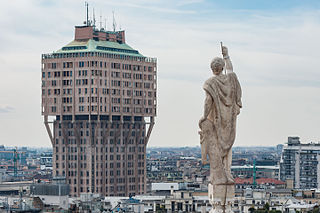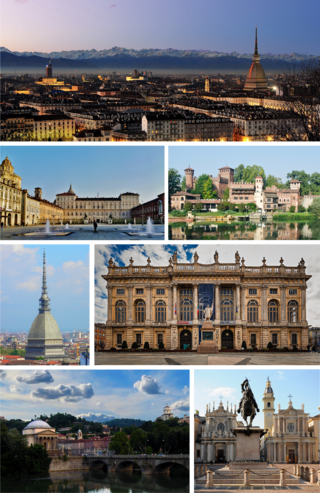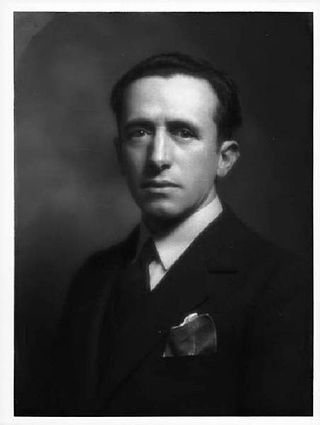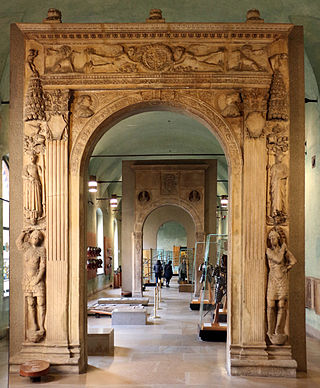
Ernesto Nathan Rogers was an Italian architect, writer and educator.

Giuseppe Pagano was an Italian architect, notable for his involvement in the movement of rationalist architecture in Italy up to the end of the Second World War. He designed exhibitions, furniture and interiors and was an amateur photographer. He was also a long-time editor of the magazine Casabella.

Ignazio Gardella was an Italian architect and designer.

The Torre Velasca is a skyscraper built in the 1950s by the BBPR architectural partnership, in Milan, Italy. The tower is part of the first generation of Italian modern architecture, while still being part of the Milanese context in which it was born, to which also belongs the Milan Cathedral and the Sforza Castle.

Luca Beltrami was an Italian architect and architectural historian, known particularly for restoration projects.

Turin is a city and an important business and cultural centre in Northern Italy. It is the capital city of Piedmont and of the Metropolitan City of Turin, and was the first Italian capital from 1861 to 1865. The city is mainly on the western bank of the Po River, below its Susa Valley, and is surrounded by the western Alpine arch and Superga hill. The population of the city proper is 843,514, while the population of the urban area is estimated by Eurostat to be 1.7 million inhabitants. The Turin metropolitan area is estimated by the OECD to have a population of 2.2 million.

Villas and palaces in Milan are used to indicate public and private buildings in Milan of particular artistic and architectural value. Milan has always been an important centre with regard to the construction of historical villas and palaces, ranging from the Romanesque to the neo-Gothic, from Baroque to Rococo.

The Zone 1 of Milan, since 2016 officially Municipality 1 of Milan, is one of the 9 administrative divisions of Milan, Italy.

The Palazzo Belgioioso is a palatial residence in the northern Italian city of Milan, completed in 1781 in a Neoclassical style by Giuseppe Piermarini.
Paolo Brescia is an Italian architect and founder of OBR Open Building Research. He graduated with a degree in architecture from the Politecnico di Milano in 1996 and had his academic fellowship at Architectural Association in London. After working with Renzo Piano, he founded in 2000 OBR with Tommaso Principi to investigate new ways of contemporary living, creating a design network among Milan, London, Mumbai and New York. He combines his professional experience with the academic world as guest lecturer in several athenaeums, such as Accademia di Architettura di Mendrisio, Kent State University, Aalto University, University of Oulu, Academy of Architecture of Mumbai, College of Architecture of Pune, Mimar Sinan Fine Art University, Hacettepe University, Florida International University in Miami. He was university professor in charge at Politecnico di Milano (2004-2005) and University of Genoa (2013-2015). With OBR his projects have been featured in international exhibitions, including at X Biennale di Architettura in Venice 2006; RIBA Royal Institute of British Architects in London 2007; V Bienal de Arquitetura in Brasilia 2007; XI Bienal Internacional de Arquitectura in Buenos Aires 2007; AR Award Exhibition in Berlin 2008; China International Architectural Expo in Beijing 2009; International Expo in Shangai 2010; UIA 24th World Congress of Architecture in Tokyo 2011; Energy at MAXXI in Rome 2013; Italy Now in Bogotá 2014; Small Utopias in Johannesburg 2014; XIV Biennale di Architettura in Venice 2014; Triennale di Milano in Milan 2015 and Cooper Hewitt Smithsonian Design Museum in New York 2016.
Angelo Torricelli is an Italian architect.

Piero Portaluppi was an Italian architect.

The following outline is provided as an overview of and topical guide to Milan:

Eugenio Soncini was an Italian architect.

The Galleria del Corso is a major shopping arcade in the historic center of Milan, Italy, one of five built in the city in the interwar period (1919–39), along with the Galleria del Toro, Galleria Mazzini, Galleria Meravigli and the Galleria Gonzaga.

Giovanni Greppi was an Italian architect best known for having designed some of the most famous military shrines in Italy.

Piazza Gae Aulenti is a pedestrian square in the city of Milan.

The Palazzo del Banco Mediceo or simply Banco Mediceo, was a palace in Milan, the Milanese seat of the Medici's financial exchange activities, known throughout Europe as the Medici Bank. It was one of the earliest examples of Lombard Renaissance architecture.






















